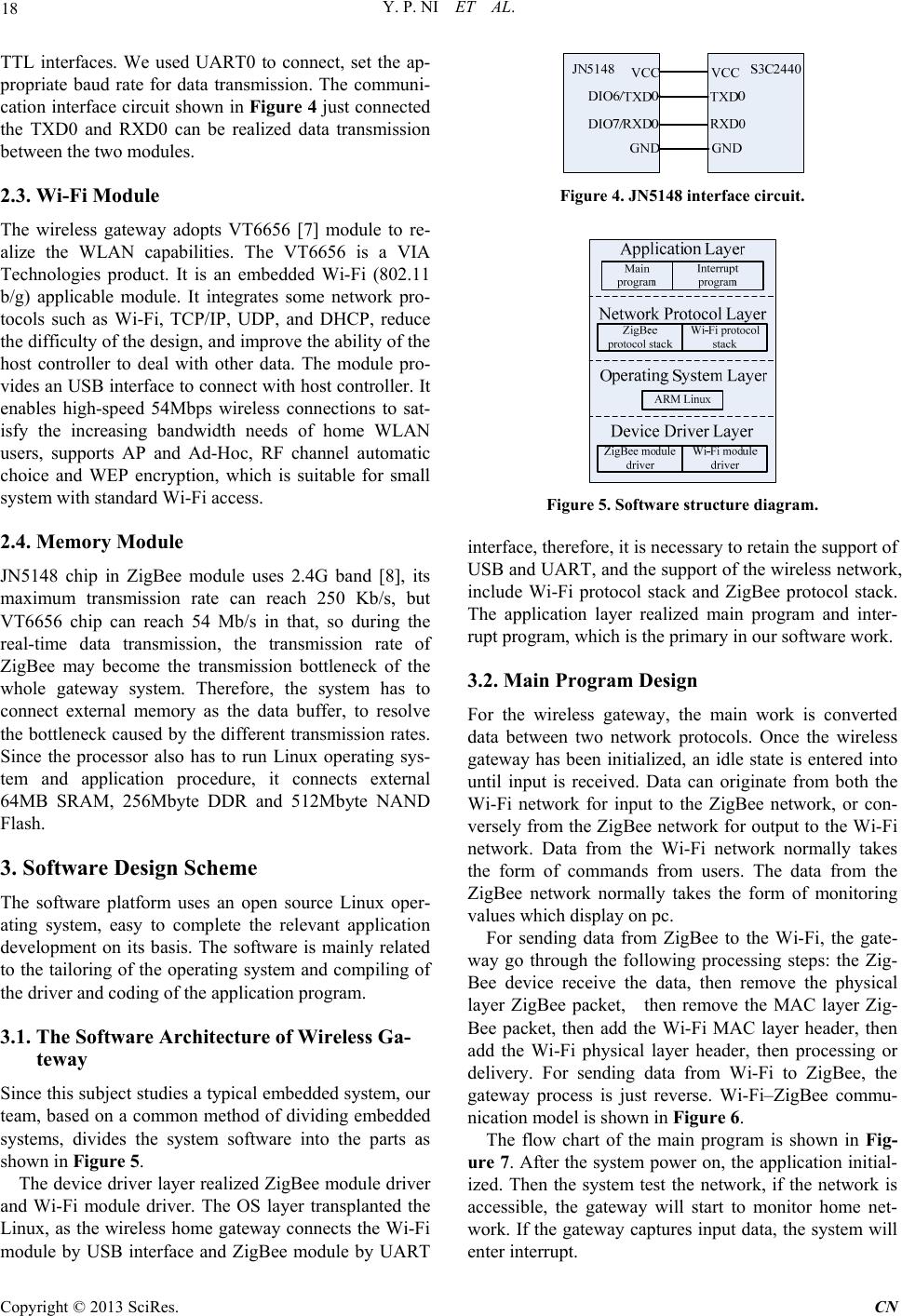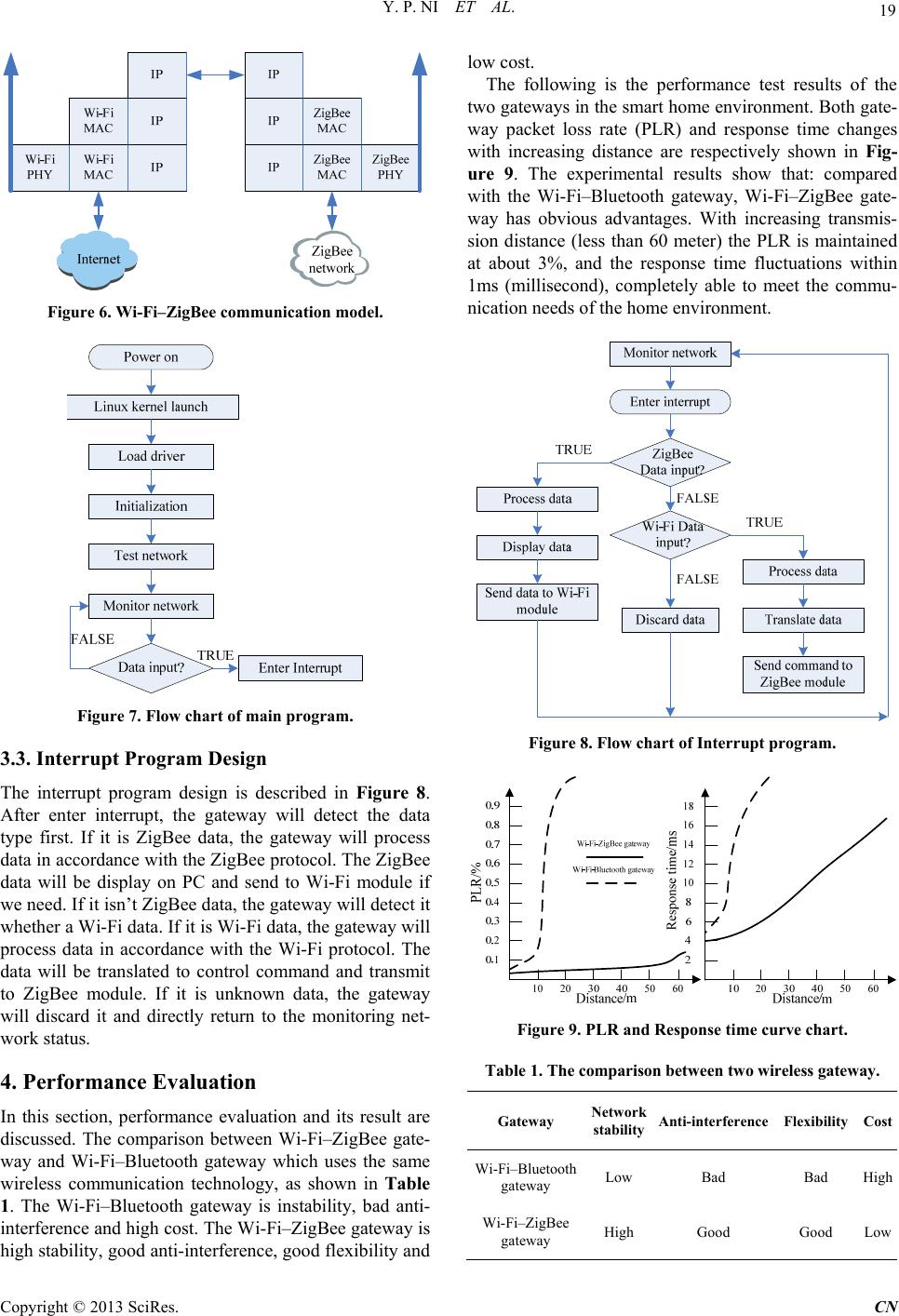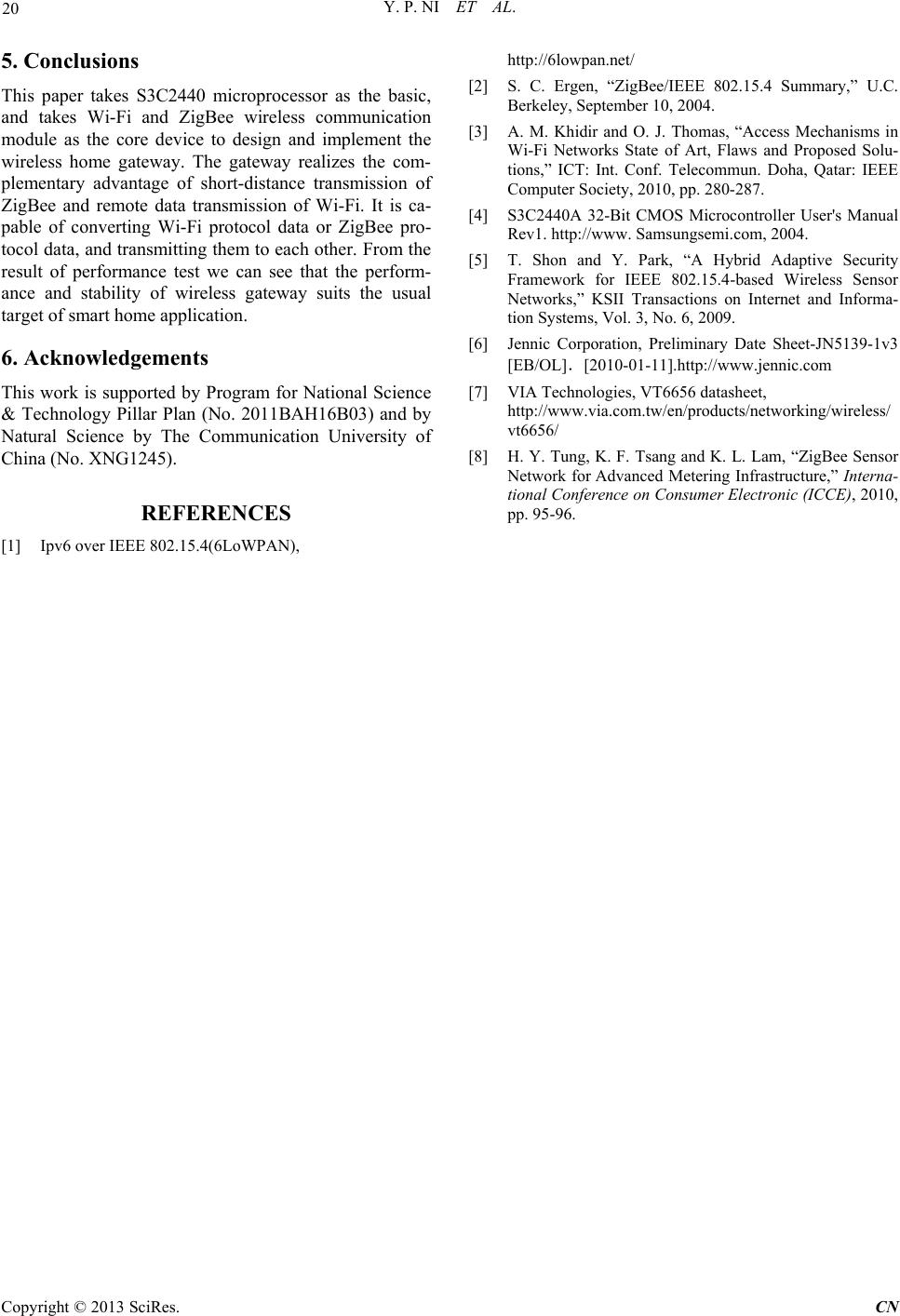Paper Menu >>
Journal Menu >>
 Communications and Network, 2013, 5, 16-20 doi:10.4236/cn.2013.51B005 Published Online February 2013 (http://www.scirp.org/journal/cn) Implementation of Wireless Gateway for Smart Home Yepeng Ni1, Fang Miao2, Jian bo Liu2, Jianping Chai2 1Computer and Network Center, Communication University of China, Beijing, China 2Information Engineering School, Communication University of China, Beijing, China Email: nyp_2010@cuc.edu.cn, jp_chai@cuc.edu.cn Received 2012 ABSTRACT In recent years, the ZigBee network has been rapid develop in smart home. In order to solve the interconnection prob- lem between the ZigBee network and the internet in the smart home, a wireless home gateway based on embedded is designed and implemented in this paper. The gateway is made up of the main controller S3C2440, the ZigBee module JN5148 and the Wi-Fi module VT6656. It is capable of converting Wi-Fi protocol data or ZigBee protocol data, and transmitting them to each other. The paper describes the design and implementation process of the gateway hardware and software, introduces the Wi-Fi protocol data and the ZigBee protocol data conversion method, and solve the bottle- neck caused by the two protocol different transmission rates. Then the performance of the gateway is tested, and the results indicate that the performance is stable, and the Wi-Fi–ZigBee gateway is completely meeting the needs of the smart home. Keywords: ZigBee; Wi-Fi; Smart Home; S3C2440; JN5148; VT6656 1. Introduction In recent years, with the rapid development of the com- puter technology, the communication technology and the network technology, the smart home is becoming the future direction and more and more people thirst for smarter and more comfortable life. Smart home can not only to provide healthy, safe and comfortable living en- vironment, and users can also remote monitoring their home state and control Household appliances. In the smart home system, using wireless network technology can provide greater flexibility, mobility, and more in line with the commun ication features of the home netwo rk. In the past, people used to adopt the Bluetooth technology to build the home network. It has many advantages, and it also has many defects especially for home automation, For example, it is too complicated, large-power consum- ing and it has a short distance of communication, a high price and too small-scale network. However, if we use ZigBee [1] technology, it will be able to solve the prob- lem and ensure the security and reliability of data com- munication. ZigBee is a low-rate, low-power, low-cost wireless networking protocol that is targeted toward automation and remote control applications and is designed to pro- vide connectivity for equipment that will operate for as long as several years [2]. The ZigBee home networks make possible networks such as the following Figure 1. Smart home wireless network can be achieved using ZigBee alone. To enable the expansion of conventional wireless control networks, however, we must maintain compatibility with curren t Wi-Fi protocol. Wi-Fi [3] as a wireless networking technology, the most important ad- vantage is that does not require wiring and not subject to the constraints of wiring. Wi-Fi technology makes smart home networks connected to the Internet more conven- ient. Wi-Fi is used for two primary purposes. Firstly, it is used to provide access to the home automation system from Wi-Fi enabled devices, as an alternative to the Zig- bee based local controller. This approach was taken be- cause homes increasingly have Wi-Fi networks and Wi-Fi enabled devices such as PDA’s and mobile phones. Secondly, it is used to provide remotely monitor and control through accessing internet. In this way, users can remotely monitor and control their home devices using a device connected to the internet. The conceptual design of home automation infrastructure is as shown in Figure 2. In this paper, a novel, low-cost, and lightweight Wi- Fi–ZigBee wireless gateway is introduced. It contains two functions. The one is this system uses ZigBee tech- nology to transmit the data collected from the node net- work to the embedded gateway, and then communicates with the monitoring PC by Wi-Fi network through the gateway. For another, it is uses Wi-Fi module to send *This work is supported by Program for National Science & Technol- ogy Pillar Plan (No. 2011BAH16B03) and by Natural Scienceby The Communication University of China ( No. XNG1143). Copyright © 2013 SciRes. CN  Y. P. NI ET AL. 17 commands from monitoring PC to ZigBee network, and then control home device. The combination of ZigBee and Wi-Fi has a very important significance in the wire- less gateway system. Figure 2 displays the gateway op- eration model. This paper is organized as follows: Section 2 discusses the gateway hardware design scheme, including a review of the module used. Section 3 describes the implementa- tion of the gateway software. Section 4 provides a dis- cussion of t he system evaluation an d S ec tion 5 provides a conclusion. 2. Hardware Design Scheme The hardware platform of wireless gateway is made up of four parts: the controller module, storage module, ZigBee module and Wi-Fi module. The structure is demonstrated in Figure 3. 2.1. Controller Module The controller is the core of the embedded home gateway, it uses Zigbee module to configure the Zigbee terminal node and receive the node’s data, using Wi-Fi protocol to Figure 1. ZigBee home networks. Figure 2. Home automation infrastructure overview. Figure 3. Hardware structure diagram. make connection between gateway and the Internet via Wi-Fi module. Taking into consideration the main func- tion of the core processor and the characteristics of other processors within the system, we choose the S3C2440 chip of ARM920T kernel as the core processor. This core board is characterized by modest expense, low power consumption, high efficiency, plentiful external interface and a read-write speed of 400 MHZ, all of which makes it suitable for network communication and device control [4]. 2.2. ZigBee Networking Module We use Zigbee technology to make intelligent home ap- pliance equipment composition star network in smart home system. The star network consists of a coordinator, routers and several end devices. The coordinator is re- sponsible for starting and controlling th e ZigBee network. The coordinator [5] stores information about the network, which includes acting as the Trust Center and being the repository for security keys. The routers extend network area coverage, dynamically route around obstacles, and provide backup routes in case of network congestion or device failure. They can connect to the coordinator and other routers, and also support child devices. The end devices can transmit or receive a message, but cannot perform any routing operations. They must be connected to either the coordinator or a router, and do not support child devices. The end devices include home appliances, door lock sensor, gas and smoke sensor, and CCTV etc. We use the JN5148 as the ZigBee module [6]. The JN5148 is a Jennic cor poration prod uct, it is a ultra low power, high performance surface mount module targeted at ZigBee PRO networking applications, enabling users to realize products with minimum time to market and at the lowest cost. The modules provide a comprehensive solution with large memory, high CPU and radio per- formance and all RF components included. The module is connected to S3C2440 via the UART. Amount the three universal asynchronous serial interfaces, the UART0 is a RS232 interface, UART1 and UART2 is Copyright © 2013 SciRes. CN  Y. P. NI ET AL. 18 TTL interfaces. We used UART0 to connect, set the ap- propriate baud rate for data transmission. The communi- cation interface circuit shown in Figure 4 just connected the TXD0 and RXD0 can be realized data transmission between the two modules. 2.3. Wi-Fi Module The wireless gateway adopts VT6656 [7] module to re- alize the WLAN capabilities. The VT6656 is a VIA Technologies product. It is an embedded Wi-Fi (802.11 b/g) applicable module. It integrates some network pro- tocols such as Wi-Fi, TCP/IP, UDP, and DHCP, reduce the difficulty of the de sign, and impr ov e the ability o f the host controller to deal with other data. The module pro- vides an USB interface to connect with host controller. It enables high-speed 54Mbps wireless connections to sat- isfy the increasing bandwidth needs of home WLAN users, supports AP and Ad-Hoc, RF channel automatic choice and WEP encryption, which is suitable for small system with standard Wi-Fi access. 2.4. Memory Module JN5148 chip in ZigBee module uses 2.4G band [8], its maximum transmission rate can reach 250 Kb/s, but VT6656 chip can reach 54 Mb/s in that, so during the real-time data transmission, the transmission rate of ZigBee may become the transmission bottleneck of the whole gateway system. Therefore, the system has to connect external memory as the data buffer, to resolve the bottleneck caused by the different transmission rates. Since the processor also has to run Linux operating sys- tem and application procedure, it connects external 64MB SRAM, 256Mbyte DDR and 512Mbyte NAND Flash. 3. Software Design Scheme The software platform uses an open source Linux oper- ating system, easy to complete the relevant application development on its basis. The software is mainly related to the tailoring of the operating system and compiling of the driver and coding of the application program. 3.1. The Software Architecture of Wireless Ga- teway Since this subject studies a typical embedded system, our team, based on a common method of dividing embedded systems, divides the system software into the parts as shown in Figure 5. The device driver layer realized ZigBee module driver and Wi-Fi module driver. The OS layer transplanted the Linux, as the wireless home gateway connects the Wi-Fi module by USB interface and ZigBee module by UART Figure 4. JN5148 interface circuit. Figure 5. Software structure diagram. interface, therefore, it is necessary to retain the support of USB and UART, and the supp ort of the wireless networ k, include Wi-Fi protocol stack and ZigBee protocol stack. The application layer realized main program and inter- rupt program, which is the primary in our software work. 3.2. Main Program Design For the wireless gateway, the main work is converted data between two network protocols. Once the wireless gateway has been initialized, an idle state is entered into until input is received. Data can originate from both the Wi-Fi network for input to the ZigBee network, or con- versely from the ZigBee network for output to the Wi-Fi network. Data from the Wi-Fi network normally takes the form of commands from users. The data from the ZigBee network normally takes the form of monitoring values which display on pc. For sending data from ZigBee to the Wi-Fi, the gate- way go through the following processing steps: the Zig- Bee device receive the data, then remove the physical layer ZigBee packet, then remove the MAC layer Zig- Bee packet, then add the Wi-Fi MAC layer header, then add the Wi-Fi physical layer header, then processing or delivery. For sending data from Wi-Fi to ZigBee, the gateway process is just reverse. Wi-Fi–ZigBee commu- nication model is shown in Figure 6. The flow chart of the main program is shown in Fig- ure 7. After the system power on, the application initial- ized. Then the system test the network, if the network is accessible, the gateway will start to monitor home net- work. If the gateway captures input data, the system will enter interrupt. Copyright © 2013 SciRes. CN  Y. P. NI ET AL. 19 Figure 6. Wi-Fi–ZigBee communication model. Figure 7. Flow chart of main program. 3.3. Interrupt Program Design The interrupt program design is described in Figure 8. After enter interrupt, the gateway will detect the data type first. If it is ZigBee data, the gateway will process data in accordance with the ZigBee protocol. The ZigBee data will be display on PC and send to Wi-Fi module if we need. If it isn’t ZigBee data, the gateway will detect it whether a Wi-Fi data. If it is Wi-Fi data, the gateway will process data in accordance with the Wi-Fi protocol. The data will be translated to control command and transmit to ZigBee module. If it is unknown data, the gateway will discard it and directly return to the monitoring net- work status. 4. Performance Evaluation In this section, performance evaluation and its result are discussed. The comparison between Wi-Fi–ZigBee gate- way and Wi-Fi–Bluetooth gateway which uses the same wireless communication technology, as shown in Table 1. The Wi-Fi–Bluetooth gateway is instability, bad anti- interference and high cost. The Wi-Fi–ZigBee gateway is high stability, good anti-interference, goo d flexibility and low cost. The following is the performance test results of the two gateways in the smart home environment. Both gate- way packet loss rate (PLR) and response time changes with increasing distance are respectively shown in Fig- ure 9. The experimental results show that: compared with the Wi-Fi–Bluetooth gateway, Wi-Fi–ZigBee gate- way has obvious advantages. With increasing transmis- sion distance (less than 60 meter) the PLR is maintained at about 3%, and the response time fluctuations within 1ms (millisecond), completely able to meet the commu- nication needs of the home environ ment. Figure 8. Flow chart of Interrupt program. Figure 9. PLR and Response time curve chart. Table 1. The comparison between two wireless gateway. Gateway Network stability Anti-interference FlexibilityCost Wi-Fi–Bluetooth gateway Low Bad Bad High Wi-Fi–ZigBee gateway High Good Good Low Copyright © 2013 SciRes. CN  Y. P. NI ET AL. Copyright © 2013 SciRes. CN 20 5. Conclusions This paper takes S3C2440 microprocessor as the basic, and takes Wi-Fi and ZigBee wireless communication module as the core device to design and implement the wireless home gateway. The gateway realizes the com- plementary advantage of short-distance transmission of ZigBee and remote data transmission of Wi-Fi. It is ca- pable of converting Wi-Fi protocol data or ZigBee pro- tocol data, and transmitting them to each other. From the result of performance test we can see that the perform- ance and stability of wireless gateway suits the usual target of smart home application. 6. Acknowledgements This work is supported by Program for National Science & Technology Pillar Plan (No. 2011BAH16B03) and by Natural Science by The Communication University of China (No. XNG1245). REFERENCES [1] Ipv6 over IEEE 802.15.4(6LoWPAN), http://6lowpan.net/ [2] S. C. Ergen, “ZigBee/IEEE 802.15.4 Summary,” U.C. Berkeley, September 10, 2004. [3] A. M. Khidir and O. J. Thomas, “Access Mechanisms in Wi-Fi Networks State of Art, Flaws and Proposed Solu- tions,” ICT: Int. Conf. Telecommun. Doha, Qatar: IEEE Computer Society, 2010, pp. 280-287. [4] S3C2440A 32-Bit CMOS Microcontroller User's Manual Rev1. http://www. Samsungsemi.com, 2004. [5] T. Shon and Y. Park, “A Hybrid Adaptive Security Framework for IEEE 802.15.4-based Wireless Sensor Networks,” KSII Transactions on Internet and Informa- tion Systems, Vol. 3, No. 6, 2009. [6] Jennic Corporation, Preliminary Date Sheet-JN5139-1v3 [EB/OL].[2010-01-11].http://www.jennic.com [7] VIA Technologies, VT6656 datasheet, http://www.via.com.tw/en/products/networking/wireless/ vt6656/ [8] H. Y. Tung, K. F. Tsang and K. L. Lam, “ZigBee Sensor Network for Advanced Metering Infrastructure,” Interna- tional Conference on Consumer Electronic (ICCE), 2010, pp. 95-96. |

